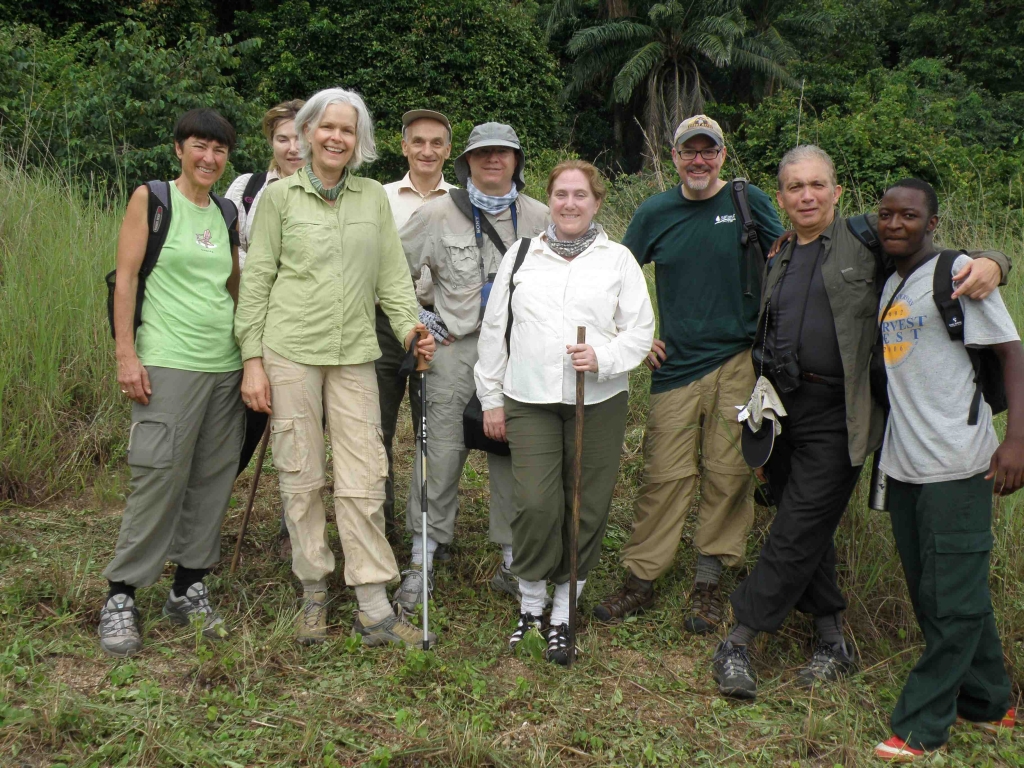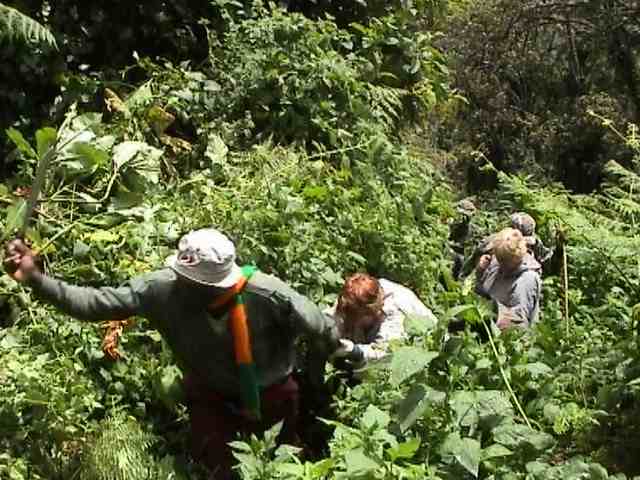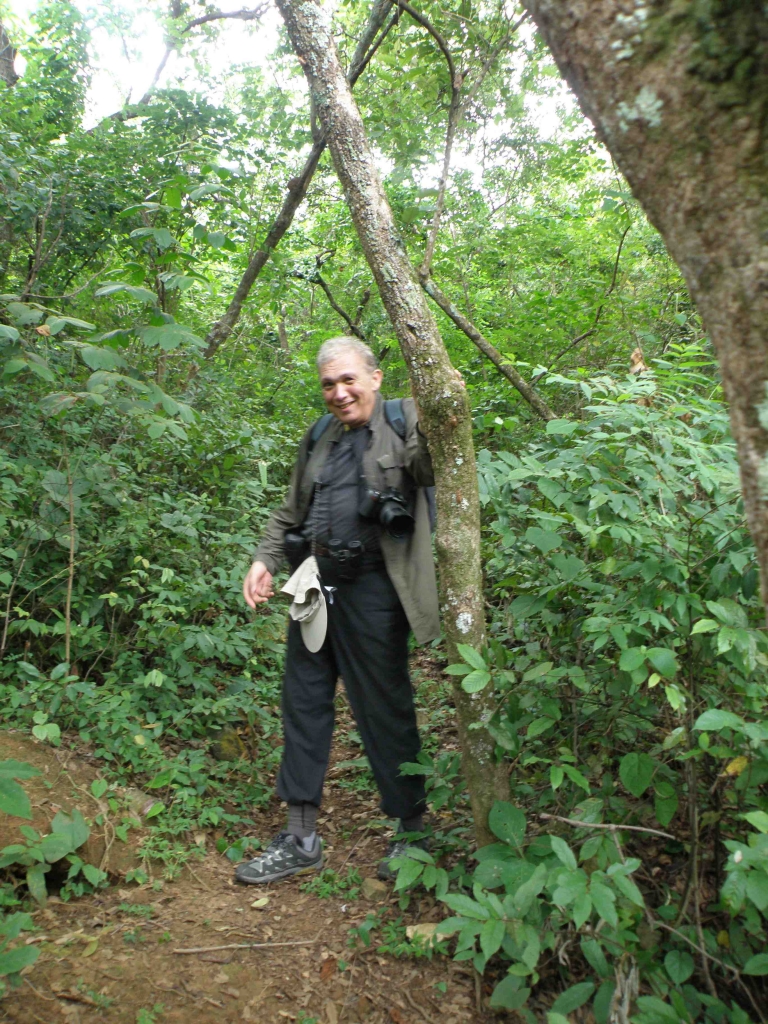We’ve been walking for only ten minutes when a deafening scream surrounds us, silencing the forest’s chirping, buzzing, and clicking sounds.
The spine-chilling screams act as beacons.
So does the walky-talky Emmiti, our guide, carries to communicate with trackers who start before dawn to locate where the chimpanzees have bedded down the night before, so the researchers can follow them the rest of the day.
Seeing chimps and gorillas in the wild is a dream for many.
Travelers often ask me “how fit do I need to be” to see apes in the wild.
It’s a good question. But difficult to answer.
Sometimes the animals are very near, and other times finding them requires hours (and miles) of trekking through mostly dense forest.
I have had eighty-year old clients make the trek (with the help of able bodied guides). Being fit helps, but the determination to see the chimps or gorillas is just as, if not more important than, your level of fitness.
If you dream of one day seeing chimpanzees (or gorillas) in the wild, this post will give you a reality check on what it takes to have this special, once- in- a- lifetime wild ape experience.
*****
Emmiti nods to me – his way of indicating we are about to have the thrill my group has traveled by plane, boat and now foot for: to see the chimpanzees of Gombe Stream Park in Tanzania. The park where 26 year old Jane Goodall (accompanied by her mother Vanne) came in 1960 to study chimpanzees.
“They are very near,” I tell my clients, thinking to myself how lucky we are to find the chimps after only twenty minutes of hiking.
Gombe is Tanzania smallest Park, although the research started by Dr. Jane is the worlds longest running study of it’s kind. We are looking for members of the Kasakela community. The F and G and T named families of our closest genetic relatives that showed Jane tool making and other human like behavior.
Emmiti points, and leads us off the path.
As we crawl under twisted bundles of vines, and step over fallen trees in this dense humid forest, I can hear the chimps leaping and jumping through the tallest trees, grabbing the small orange fruit of the budyenkende, one of their main food sources.
But I can’t see them.
We are now two hours into our hike and we still haven’t caught up to the pant hoot calls from what sounds like a large group of chimps.
They are moving too fast, farther up the mountain ahead of us.
Our third hour of hiking and Emmiti leads us bush whacking up a steep incline with the hope of intersecting the troop. “We are very near,” he says.
Using thin twigged branches to help pull myself uphill, the pebbled dirt slides away with each slow step.
Our group stops for a break, everyone leaning against the hill, shirts stained with dark patches, beads of sweat dripping down our faces.
“Does anyone want to turn back?” I ask.
Water bottles held to their mouths, everyone shakes their head, NO.
As I rest there, spread eagle across the hillside, time lapsed images flash to mind.
One, of army ants devouring my flesh a small chunk at a time, and another of strangler vines like the kind currently wrapped around my legs, smothering me in a cocoon before turning me into forest compost.
I reach down to tuck the bottom of my pant legs more tightly into my calf high socks (a must have item for hiking in Gombe), as protection against ants, and remind others to do the same.
“Ok, let’s keeping going.” I say to the group.
As we unwrap vines from our legs and inch ourselves upwards, Emmiti says for the fourth time today, “We are very near.”
But, when we reach the top of the hill, Gombe forest has gone silent.
So I prepare myself for the fact that this will be the first time in the eight years I have lead safaris to Gombe Park for the Jane Goodall Institute that we will not be successful in our attempts to see chimpanzees in the wild.
*****
What do you think –do we find the chimps afterall?
What about you – are you up for the challenge of hiking in Gombe Park to find the chimpanzees?
Consult with me, Lori Robinson, Safari Specialist since 2004.





Certainly trekking through the impenetrable forest in Bwindi to see mountain gorillas (it’s not called impenetrable for nothing …) required significant physical exertion for me! While tracking chimps through the rainforest in Budongo was not difficult at all … very flat terrain. Your experience appears quite strenuous, but I concur that a heart and mind focused on the task can accomplish amazing feats. 🙂 And it’s so totally worth it!
The thing is, you never know how hard it will be so I hope this gives readers one perspective of what it can be like. And agreed, totally worth it.
I remember every step that you described. I’ve been to Uganda and Rwanda to see Mountain Gorillas and it’s all worth the difficult trek. It’s a thrill to see them in their habitat.
Hi Barb, So worth it, as you say. Thanks for commenting and glad I described our experience in Gombe correctly so that you remember every step.:)
This is definitely on my list of things to do… I hope I have the strength (and endurance!) for it!
Let’s get real. I have been on trips with others who were not prepared and it held the group back. This story about seeing the chimpanzees reminds me to keep exercising on a daily basis so I can have this experience someday soon.
Thanks Sharon. You are right that you need to be pretty fit. I talk to people when they are thinking about signing up to make sure they have a reality check about what it takes to see the chimps. That said, each time it is different. Some trips it has taken hours and lots of climbing to catch up to them. Other trips, it has been an easy hike. You never know. We have never had someone who did not make it as the guides are so helpful and have even carried a woman on one of my trips to see the gorillas.